There were 133 million eyeballs watchfully awaiting Kendrick Lamar’s half-time show. Aware of this immense visibility, Lamar certainly gave us something to look at: not a halftime spectacle, but rather an uncanny reflection of ourselves in the midst of the “Great American Game.”
“The revolution is about to be televised.” This bold provocation directly invokes Gil-Scott Heron’s Black liberation poem, “The Revolution Will Not Be Televised”, a wake-up call urging us to move from passive observation to active revolutionary transformation. Lamar’s halftime performance becomes a theatrical act that intertwines choreography, set design, and narrative, to demand that we, the witnesses to his testimony, not only listen, but look. Better yet, that we see beyond the surface spectacle and examine the systems at play.
The performance opens with the teaser from Lamar’s latest album, GNX. We are introduced to three key figures: Uncle Sam, played by Samuel L. Jackson, who directs the action; Kendrick Lamar, our observer and interlocutor; and a semi-uniformed troupe of dancers (presumably representing the American body politic) dressed in red, white, and blue, spilling out from a black Buick GNX. Throughout the performance, choreographer and veteran pgLang collaborator, Charm La’Donna, employs formations and textural variation in her choreography to evoke the changing state of the body politic. Look closely. Full of adrenaline and unconstrained energy the dancers move freely, expressively; stomping, jabbing, swinging. When the first call to arms arrives in Squabble Up, a troupe of red-clad women ready themselves for battle, bobbing like NPCs with fists ready for a scrappy fist-to-cuffs squabble. We soon learn from Uncle Sam that this mode of combat is “too loud, too reckless, too ghetto.”
Evolving their strategy, the uniformed dancers start to organise, tightening up from an unmoderated mass to soldiers in formation. The score’s percussion is furnished by militarised boots hitting the ground and the dancers stepping back in line to form the American flag, just as Uncle Sam requested. As we transition into the staccato piano motif of Humble, the choreography becomes even more conditioned and mechanical. Nodding their heads and moving their hands in unison; these uniformed men become puppets of the system. In addition to the choreography, the stage and production design manifest deeper layers of meaning. Creative trio, Bruce Rodgers, Dave Free and Mike Carson render the staging a narrative device in and of itself.
The steps upon which the human-flag stands recall the very architecture of power: the nation’s city halls, the Supreme Court, the Capitol. We witness the uniformed men cede their agency to become rank and file pawns on the American game board. Obliging to the command, “Be humble. Sit down.” the men descend a step lower with each invocation of the order. Euphoria charges the scene forward. Anthemic horns swell, as the body politic prepares for battle, filing into columns like a military parade, red, white, then blue—order enforced.
The scene clears and resets with Man at the Garden. We are met with Kendrick and his “homeboys” who are decidedly un-uniformed in white tees and jeans. Overhead, another homeboy rests on a lamp post. This is no doubt a reference to Lamar’s Alright, which has become both an affirmation and a protest for Black life. While I have heard friends bemoan the absence of the track in the performance itself, the message central to the anthem pervades. The “we” addressed in Alright is his community: the homeboys who keep watch, who look out for one another. This is not the first time that the homeboys have made an appearance. In the intro, you’ll notice the homeboys are the last to exit the Buick, the camera pays them little mind. In the background, they circle Lamar forming his parade as well as his protection. Now, the homeboys get to take up space on the screen.

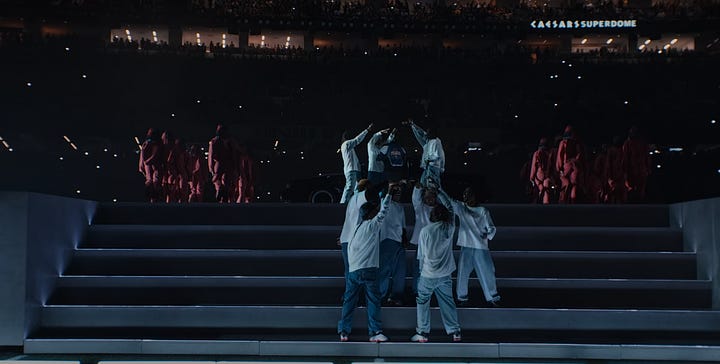
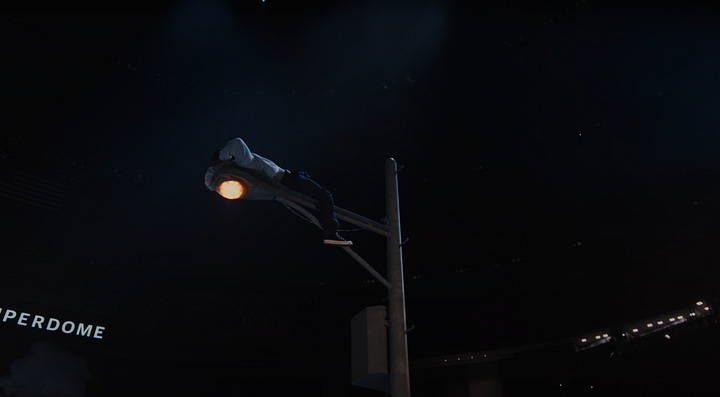
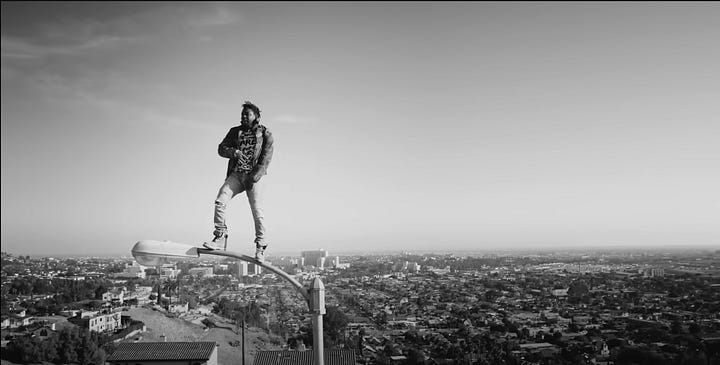
They bop together, fingers snapping, bassy vocal flowing from their lips. Joy as golden as their grills. However, their stint in the spotlight is short-lived as they are chased away by Uncle Sam, who condemns their collective solidarity as a threat to the integrity of the game. “I see you brought the homeboys with you. The old culture cheat code.” he mocks. His tone all the more ominous, he orders the “scorekeeper” to deduct one life. A life deducted can be read as a small penalty for breaking the rules, but more pressingly, as a reference to the brutal and often lethal policing of Black communities.
As Peekaboo thumps in, we find ourselves within the “sin bin,” a red “X” confining the ensemble like prisoners on a larger game board. The energy is both claustrophobic yet explosive. Like a vigorously shaken can of Coca-cola, the mass is barely contained, both within the red perspex walls as well as the camera frame. The tension is nearing its limit. The moment feels ripe for the bold and bullish battle rap Not Like Us. Instead, Kendrick teases us at the precipice of a climax and opts to cool the heat; slow things down.
Sweeping us into the velvety, soulfulness of Luther, the fervour and momentum is seemingly diffused. For the first time, we witness softness in both form and physicality. The dancers trace soft curved paths across the field to lead us to our next guest, SZA. The dancers move with sensuality in sharp contrast to the aggression and rigidity of the previous scenes. The music melts into All The Stars, Kendrick and SZA’s ethereal duet from the Black Panther soundtrack (Note: another widely televised tale). For many, the film sparked visions of a Black Utopia, but what is a dream disconnected from real-world action? As SZA repeats the mantra, “Maybe tonight my dreams might let me know// All the stars are closer,” the ensemble moves in a circular march—ascending only to descend again, trapped in a futile cycle. The message is clear: no matter how hard we strive within the framework of the game, utopia remains elusive. This “dream” is a televised illusion, a sedative that dulls our suspicions, keeping us "nice and calm" so America can continue as it pleases.
Just as Uncle Sam’s appetite for submission is almost satiated, Kendrick unleashes his final act, Not Like Us. This act is many things: it is the meme-worthy spectacle the internet has been waiting for. The punchline that punts eggs straight at Drake’s face. But don’t be distracted by the trivial spats of the Drake v. Kendrick feud – there’s a larger battle at hand. As Kendrick declares “40 acres and mule. This is bigger than the music.” Not Like Us is a confrontation and rebuttal to America’s illusion of control and submission.
[THIS] IS AS MUCH ABOUT “THEM”, THE CONTROLLERS OF THE GAME, AS IT IS ABOUT “US”, MEMBERS OF THE BODY POLITIC. HOW WILL WE CHOOSE TO MOVE FROM HERE?
The choreographic choices in this final act are pregnant with meaning. Set to a grand fanfare of trumpets, the uniformed ensemble marches in place, repeating a sequence of minuscule robotic gestures: hands over eyes, head clicks left, then right, only gazing forward through the TV screen formed between with their thumbs and index fingers. The command to “turn the TV off” grows ever more urgent, a call to break free from the narrow and ambiguous vision of ‘victory’ imposed by the game. In a split-second shot, we are privy to a foreboding prophecy: red, white and blue bodies laid out on the ground like forensic chalk outlines. The consequence of our complacency. The only survivors are the homeboys. Stood defiantly in a circle, they are the embodiment of solidarity.

Resuming from the prophecy, the uniformed soldiers are confined to their rigid lines, positioned for confrontation (not dissimilar to the choreography of football). Meanwhile the homeboys display unity beyond the charged battlefield. They have eyes in every direction. They, once again, keep watch from atop the lamp posts. From where they sit, they recognise the game controller laid out on the field and refuse to be played. It is collective awareness that keeps them free. They dance joyously while the uniforms continue to hold their lines, before charging at each other in a mess of bodies.
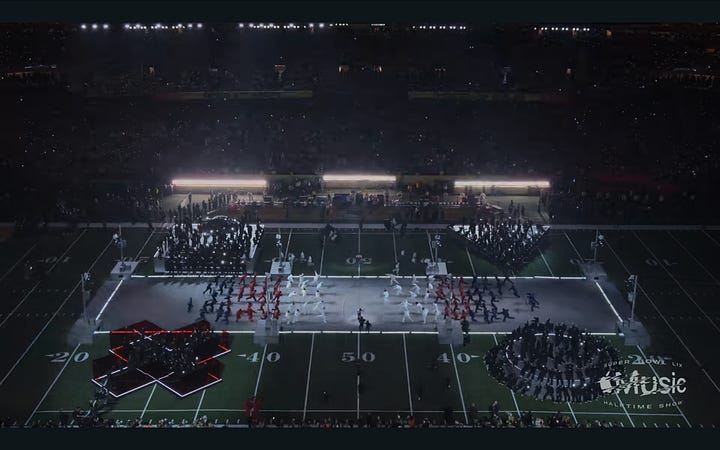
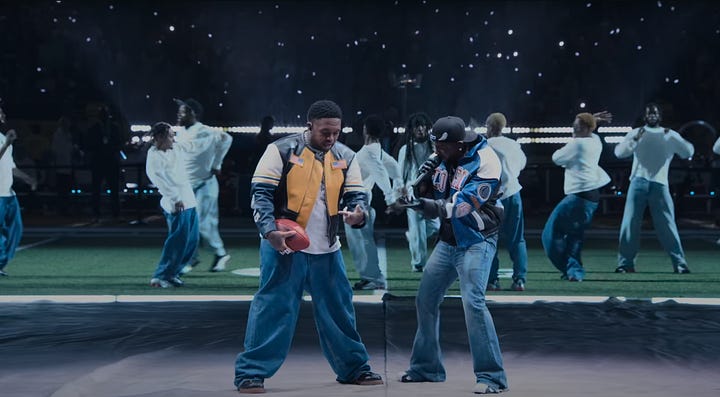
As the system crumbles into chaos, Kendrick invites an alternative: “Are you my friend?//Are we locked in?”. The ensemble reorganises from chaos to unity, taking on the form of the circle. Daps are exchanged between red, blue and white, and the collective dances together in close contact. Proof that if the community steps together, we gon’ be alright. “They tried to rig the game, but you can’t fake influence.” is as much about “them”, the controllers of the game, as it is about “us”, members of the body politic. How will we choose to move from here?


People will laud this performance as “unapologetically Black,” a middle finger to Donald Trump, a statement that “Black history is American history.” While these interpretations are valid, the aesthetics of liberation alone are not enough. The medium is the message here. Deliberately crafted for the television audience, the performance calls on us comfortably sitting on the other side of the screen to mobilize. Stay vigilant and stay on top of the game. With that, Kendrick grabs the controller and finally turns the TV off. The game is over.
To return to Gil Scott-Heron, the revolution will, in fact, not be televised. It will be where we are. Pay attention.
Look again, and look closely, tell me what you see.

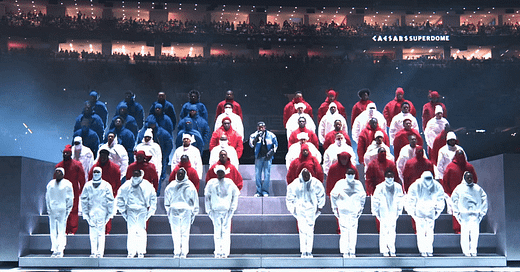


![[video-to-gif output image] [video-to-gif output image]](https://substackcdn.com/image/fetch/$s_!EVt2!,w_1456,c_limit,f_auto,q_auto:good,fl_lossy/https%3A%2F%2Fsubstack-post-media.s3.amazonaws.com%2Fpublic%2Fimages%2F7e36eccd-d831-40f2-b58b-e05df12f0404_800x443.gif)
![humble.mov [video-to-gif output image] humble.mov [video-to-gif output image]](https://substackcdn.com/image/fetch/$s_!SCwK!,w_1456,c_limit,f_auto,q_auto:good,fl_lossy/https%3A%2F%2Fsubstack-post-media.s3.amazonaws.com%2Fpublic%2Fimages%2F2ad01925-9859-486e-a8f0-8d6e8bcf3dd4_800x450.gif)
![stars.mov [optimize output image] stars.mov [optimize output image]](https://substackcdn.com/image/fetch/$s_!En8Y!,w_1456,c_limit,f_auto,q_auto:good,fl_lossy/https%3A%2F%2Fsubstack-post-media.s3.amazonaws.com%2Fpublic%2Fimages%2F99aa41f5-f1df-4de9-a9e0-3329e4482ac4_800x444.gif)

I was wondering about the men on the lampposts. Loved this line: ‘From where they sit, they recognise the game controller laid out on the field and refuse to be played.’
This is so good! I linked your article in the footnotes of mine, your attention to the choreography and the homeboys- turf dancers for the bay!- was a through line I didn’t see before, it adds so much more. I swear, this performance has so much… I’m gonna be forever studying it.